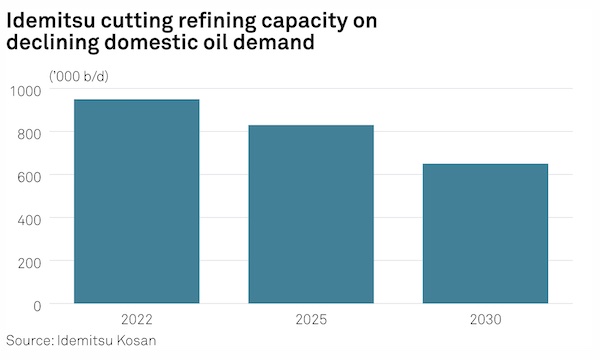Idemitsu targets late 2020s for ammonia imports from UAE, Saudi Arabia: CEO

[ad_1]

Japan’s Idemitsu Kosan aims to start importing ammonia from the UAE, Saudi Arabia and other countries in the late 2020s as it commits to supply more than 1 million mt/year of the prospective fuel to decarbonize coal-fired power generation at the Shunan industrial complex by 2030, President and CEO Shunichi Kito told S&P Global Commodity Insights.
The move comes as Idemitsu, currently the second largest Japanese refiner and a coal producer in Australia, is embarking on transforming its businesses toward carbon neutral, while ensuring immediate energy supply to its customers.
“We have many years of expertise in handling CO2 and producing hydrogen and ammonia,” Kito said in an interview at the company’s head office in Tokyo. “Since they are derived from fossil fuels, which does not offset [CO2] emissions, we are working on turning them into environmentally-friendly energy — this is what we call carbon neutral transformation.”
Its efforts at Shunan city in Yamaguchi prefecture in the western Japan has been identified by Idemitsu as a likely location for developing ammonia supply chains.
“Vinyls [production at the Shunan complex] requires a lot of electricity for electrolysis, almost all of which is currently generated by coal,” Kito said. “Although this is the source of competitiveness, we have a common headache in deciding what to do with coal.”
Idemitsu, which supplies ethylene via pipeline from its Tokuyama complex to the Shunan complex, is considering supplying carbon neutral black pellets and ammonia to help decarbonize the Shunan complex, Kito said.
Importing ammonia
Idemitsu, together with Tosoh, Tokuyama and Zeon, which were selected by the Ministry of Economy, Trade and Industry in August to run a subsidy project aimed at developing ammonia supply chains of more than 1 million mt/year by 2030 at the Shunan complex, which supplies chemical raw materials, chemicals, steel, cement and fine chemicals.
The plan is to import blue ammonia from countries such as the UAE and Saudi Arabia and get it discharged at Tokuyama and supply it to companies at the Shunan complex, Kito said.

“Such moves could be done relatively quickly,” said Kito, adding that black pellets co-burning at coal-fired power plants could also be tested without facility modifications.
Kito, however, said that importing a large amount of ammonia stably remains “a relatively high hurdle” to overcome.
Ammonia is seen as a prospective power generation fuel because it releases zero CO2 emissions when burned in a thermal power plant, starting with co-burning with coal and later for mono-fuel combustion.
Idemitsu is due to complete its first commercial 120,000 mt/year black pellet production plant, using acacia wood residues and sawdust for feedstocks in Binh Dinh Province, Vietnam in fiscal year 2022-23 (April-March).
The company, which has already successfully tested co-burning 30% of black pellets in a coal-fired boiler, plans to expand its production capacity of black pellets in Southeast Asia, Australia and the US, to 1 million mt/year in FY 2025-26 and to 3 million mt/year in FY 2030-31.
Transforming refinery
In Japan, Idemitsu is working to turn its refinery complex into the Carbon Neutral Transformation Center, including the introduction of hydrogen and ammonia as well as renewable energy, by 2030 as it aims for 2050 carbon neutrality.
As part of such efforts, Idemitsu will consider cutting an additional 180,000 b/d refining capacity by 2030 when it expects domestic oil products demand to decline by around 20% from the 2022 level.
With its planned de-commissioning of its 120,000 b/d Yamaguchi refinery by March 2024, Idemitsu’s refining capacity will fall to around 650,000 b/d in 2030 after declining to around 830,000 b/d in 2025, compared with the current 950,000 b/d capacity.
Asked about the use of the Yamaguchi facility after suspending its refining operations, Kito said: “We are precisely examining various ideas now.”
After keeping the facility as an oil storage terminal, Kito said: “We are exploring what we can do for carbon neutrality, with various ideas including solar power generation, SAF (sustainable aviation fuel) potential as well as using it as hydrogen and ammonia terminals.”
Idemitsu aims to establish 500,000 kiloliters, or 3.14 million barrels/year, of SAF production capacity in Japan by 2030 after starting supply from the world’s first 100,000 kl/year alcohol to jet technology-based SAF production plant at its Chiba complex in Tokyo Bay in 2026.
“We aim for the 500,000 kl[/year of SAF production] because we have a very high [domestic market] share of about 50% for jet fuel,” Kito said, adding that it is also looking at the Chugoku and Chubu areas in the western and central Japan for potential production in addition to likely SAF demand centers.
In addition to its SAF plans, Idemitsu is exploring ideas about developing hydrogen supply chains in the Chubu area and Kanto area in eastern Japan for industrial and power demand, as well as considering hydrogen production from renewables, carbon capture, utilization and storage and e-fuel in Hokkaido, northern Japan, for liquid fuel demand in the cold area.
“These are mostly projects we are currently working on and are certainly not just wishful thinking,” Kito said. “We might be able to see a shortlist of [business] fields, which has survived in qualifying rounds in some time away but this is not a time to decide now but to keep options open.”
Source: Platts
[ad_2]
Source link






